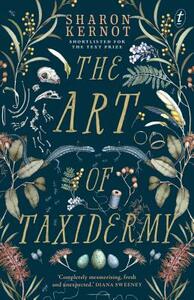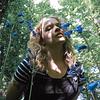Take a photo of a barcode or cover
I received this book from NetGalley in return for honest feedback.
Upon opening this book, I was skeptical. I often am with books that are structured in a poetic format as many authors have applied this technique to their novels with no other purpose than to be edgy. But I actually ended up really enjoying the poetic/artistic structuring.
Onto the actual story... I really loved the honesty with which our protagonist Lottie grappled with grief and loss. The exploration of death and normality was really thought-provoking and I found myself pausing several times to explore the different characters' understanding of what healthy grieving entails.
The only reason I didn't adore this book wholeheartedly was that there was a hidden WWII plotline that kind of cheapened the experience for me. It made it a bit unrelatable and I was craving for this book to deal with death as a very run-of-the-mill thing.
I read this book in one sitting and it was a quick one to go through, but the thoughts you are left with will last for some time. Death isn't pretty and we don't really like talking about it culturally, but it's refreshing to have an opportunity to explore death in a private way (like reading).
Upon opening this book, I was skeptical. I often am with books that are structured in a poetic format as many authors have applied this technique to their novels with no other purpose than to be edgy. But I actually ended up really enjoying the poetic/artistic structuring.
Onto the actual story... I really loved the honesty with which our protagonist Lottie grappled with grief and loss. The exploration of death and normality was really thought-provoking and I found myself pausing several times to explore the different characters' understanding of what healthy grieving entails.
The only reason I didn't adore this book wholeheartedly was that there was a hidden WWII plotline that kind of cheapened the experience for me. It made it a bit unrelatable and I was craving for this book to deal with death as a very run-of-the-mill thing.
I read this book in one sitting and it was a quick one to go through, but the thoughts you are left with will last for some time. Death isn't pretty and we don't really like talking about it culturally, but it's refreshing to have an opportunity to explore death in a private way (like reading).
I got an eARC of this book from NetGalley, but it came out a year or so ago so I think it’s just an ebook in exchange for an honest review.
A quick description of the story: Lottie collects and cares for dead animals, hoping to preserve them and save them from decaying. Her father understands her scientific mind. Her aunt wants it to stop and for her to behave more like a ‘girl’. Her mother died long ago, and she’s finding ways to be closer to her.
A warning: as the plot focuses on Lottie’s fascination with dead animals, there are some detailed descriptions of the bodies decaying and how they get taken apart and put back together for taxidermy. It’s not too intense, but this might not be a book for you if you’re easily squeamish.
The novel is written in verse
and explores love, death, grief, beauty, and the ways that people try to make sense of it all. It’s written in free verse, and it’s b e a u t i f u l. It was a slow start and took me some time to get into as it’s not a style I’m used to reading and the eBook formatting was strange, but each section is quite short and it’s broken up by illustrations like those on the cover. I do think it lacked the depth and description of an ‘actual’ novel, but I was still happy with this way of telling the story.
Representation
There’s a discussion about indigenous people and a side character – Lottie’s friend – is an Aboriginal boy. It took me a while to notice that this book was set in Australia, and I’ve never read a book featuring an Aboriginal character, so this was something I appreciated as a reader and as someone who wants to learn more.
I think it’s also worth mentioning that Lottie’s family are Germans who emigrated to Australia during World War II, and there is a lot of interesting discussion about the family history.
My one issue?
It was boring. So little happens that when something does happen it feels repetitive or forced. The book discusses a lot of sad and emotional topics, but I found it difficult to connect to them. I think this might be because Lottie seems entirely disinterested in anything that doesn’t involve taxidermy or dead animals, so it was hard to get to know her as a character and find out why I should care about her and her story.
In summary, I liked this book. The middle sections were slow and there were a few sections I wasn’t interested in as an individual, but I appreciate how this book discusses the complexity of grief.
Rating: 3.5 stars
A quick description of the story: Lottie collects and cares for dead animals, hoping to preserve them and save them from decaying. Her father understands her scientific mind. Her aunt wants it to stop and for her to behave more like a ‘girl’. Her mother died long ago, and she’s finding ways to be closer to her.
A warning: as the plot focuses on Lottie’s fascination with dead animals, there are some detailed descriptions of the bodies decaying and how they get taken apart and put back together for taxidermy. It’s not too intense, but this might not be a book for you if you’re easily squeamish.
The novel is written in verse
and explores love, death, grief, beauty, and the ways that people try to make sense of it all. It’s written in free verse, and it’s b e a u t i f u l. It was a slow start and took me some time to get into as it’s not a style I’m used to reading and the eBook formatting was strange, but each section is quite short and it’s broken up by illustrations like those on the cover. I do think it lacked the depth and description of an ‘actual’ novel, but I was still happy with this way of telling the story.
Representation
There’s a discussion about indigenous people and a side character – Lottie’s friend – is an Aboriginal boy. It took me a while to notice that this book was set in Australia, and I’ve never read a book featuring an Aboriginal character, so this was something I appreciated as a reader and as someone who wants to learn more.
I think it’s also worth mentioning that Lottie’s family are Germans who emigrated to Australia during World War II, and there is a lot of interesting discussion about the family history.
My one issue?
It was boring. So little happens that when something does happen it feels repetitive or forced. The book discusses a lot of sad and emotional topics, but I found it difficult to connect to them. I think this might be because Lottie seems entirely disinterested in anything that doesn’t involve taxidermy or dead animals, so it was hard to get to know her as a character and find out why I should care about her and her story.
In summary, I liked this book. The middle sections were slow and there were a few sections I wasn’t interested in as an individual, but I appreciate how this book discusses the complexity of grief.
Rating: 3.5 stars
3.5/5 stars. Read for ReadPlus review.
A beautiful tale with breathtaking poetic writing, literary techniques and use of symbolism.
My first novel written in verse, it’s one I won’t forget easily, and from an Australian author!
A beautiful tale with breathtaking poetic writing, literary techniques and use of symbolism.
My first novel written in verse, it’s one I won’t forget easily, and from an Australian author!
adventurous
challenging
dark
emotional
slow-paced
Plot or Character Driven:
Character
Strong character development:
Complicated
Loveable characters:
No
Diverse cast of characters:
No
Flaws of characters a main focus:
Yes
‘In lyrical language, Kernot draws a comparison between the Australian bush and death: both are beautiful and desolate at once.’
Readings
‘Kernot’s writing is imbued with life and grace and moments of infectious joy.’
SA Weekend
‘Kernot has created an intriguing tale of mystery and the imagination with a haunting ambience that the ghost of Edgar Allan Poe would recognise and admire…this is a delightful story about grief transformed and the urge to resurrect and to re-create.’
Saturday Paper
‘This book is beautifully written…while the novel is about grief, it is also about the importance of remembering and keeping the memory of loved ones alive.’
Magpies Magazine
‘The work couples the swift, clipped charm of a verse novel and the unpredictable beauty of the Australian landscape in a captivating manner that showcases an author entirely comfortable with her form…Lingers in the mind for weeks afterwards.’
Tulpa Magazine
‘[An] exquisite lyrical verse novel…[A] sharply evocative tale.’
West Weekend
‘Completely mesmerising, fresh and unexpected.’
Diana Sweeney, winner of 2013 Text Prize
‘An intense exploration of grief.’
Steven Herrick
Readings
‘Kernot’s writing is imbued with life and grace and moments of infectious joy.’
SA Weekend
‘Kernot has created an intriguing tale of mystery and the imagination with a haunting ambience that the ghost of Edgar Allan Poe would recognise and admire…this is a delightful story about grief transformed and the urge to resurrect and to re-create.’
Saturday Paper
‘This book is beautifully written…while the novel is about grief, it is also about the importance of remembering and keeping the memory of loved ones alive.’
Magpies Magazine
‘The work couples the swift, clipped charm of a verse novel and the unpredictable beauty of the Australian landscape in a captivating manner that showcases an author entirely comfortable with her form…Lingers in the mind for weeks afterwards.’
Tulpa Magazine
‘[An] exquisite lyrical verse novel…[A] sharply evocative tale.’
West Weekend
‘Completely mesmerising, fresh and unexpected.’
Diana Sweeney, winner of 2013 Text Prize
‘An intense exploration of grief.’
Steven Herrick
challenging
dark
emotional
reflective
sad
tense
medium-paced
Plot or Character Driven:
Character
Strong character development:
Complicated
Loveable characters:
Yes
Diverse cast of characters:
Yes
Flaws of characters a main focus:
Yes
emotional
medium-paced
Plot or Character Driven:
Character
Strong character development:
Yes
Loveable characters:
Yes
Diverse cast of characters:
Yes
Flaws of characters a main focus:
Yes
adventurous
emotional
reflective
sad
medium-paced
Plot or Character Driven:
Character
Strong character development:
Yes
Loveable characters:
Yes
Diverse cast of characters:
Yes
Flaws of characters a main focus:
Complicated
** A copy of The Art of Taxidermy was provided by the publisher and Edelweiss+ in exchange for an honest review **
The Art of Taxidermy is the story of a girl dealing with her grief through a morbid interest in animals and taxidermy. It's written in verse and unfortunately, I couldn't get into it. The story is heart-breaking and raw, but I didn't like the write style. Others might like this more than I did.
The Art of Taxidermy is the story of a girl dealing with her grief through a morbid interest in animals and taxidermy. It's written in verse and unfortunately, I couldn't get into it. The story is heart-breaking and raw, but I didn't like the write style. Others might like this more than I did.
This was my first verse novel, so I wasn't sure it I would take to it. I finished it in one sitting and it was glorious. It's the story of a young girl in Australia who, surrounded by death, tries in her own way to make death beautiful. I loved it. It's one of the most beautiful things I've read this year. Her love of nature, especially animals, really spoke to me and reminded me capturing and mounting butterflies. I especially appreciated that her father could see who she really was and not just a girl who should do girly things. The novel also briefly touches on Australian internment camps during WWII and what it was like to be a German who had fled Nazi Germany only to end up in an internment camp in a foreign country. Highly recommend. It didn't feel YA to me.
ARC provided by NetGalley
ARC provided by NetGalley







